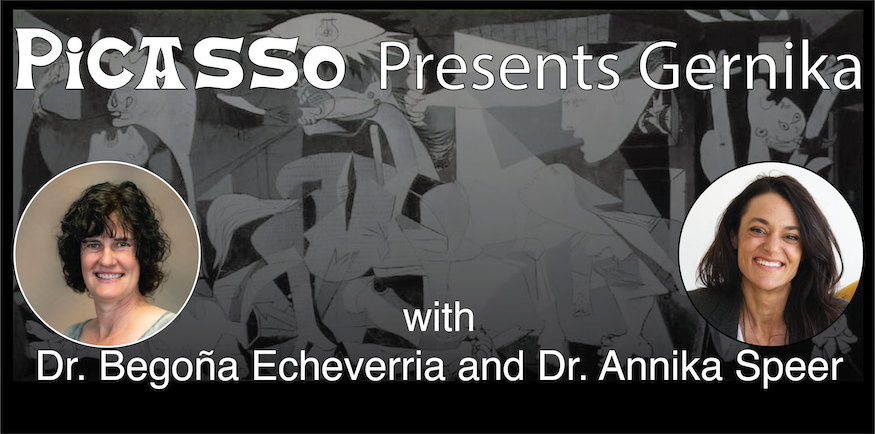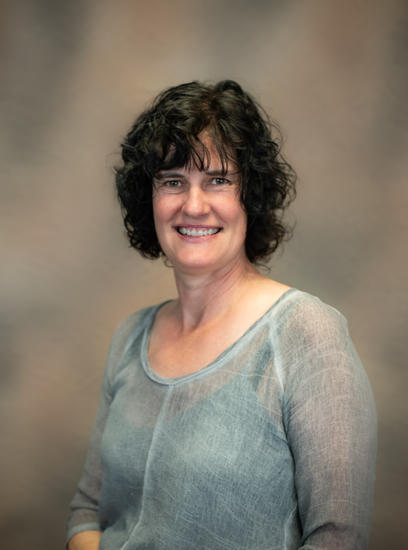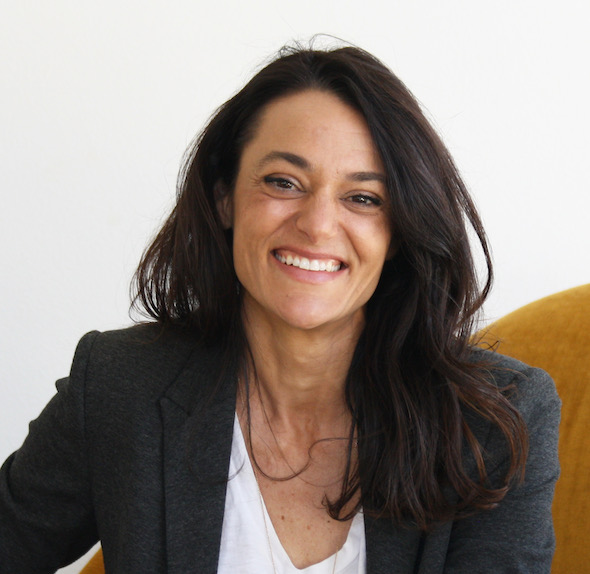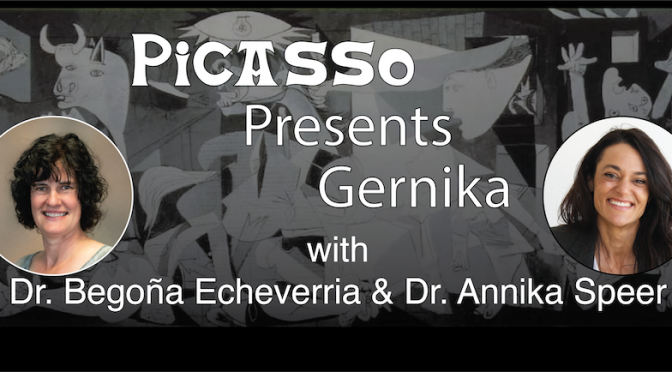
On April 26, 1937, the Basque city of Gernika was bombed. This, and other disastrous events during the Spanish Civil War, led to thousands of Basque children being evacuated from the Basque Country. In their play, Picasso Presents Gernika, Drs. Begoña Echeverria and Annika Speer, both professors at the University of California, Riverside, explore the human toll that the bombing, the war, and the evacuation had, particularly on the children. In this interview, they discuss the origins of the play, why a docudrama was the right way to present this story, and how the collaborative experience keeps evolving in unexpected directions.
Buber’s Basque Page: Begoña and Annika, thank you for taking the time to do this interview. How did your collaboration on Picasso Presents Gernika begin?
Begoña Echeverria: We were introduced by Bella Merlin, Annika’s colleague at the University of California, Riverside (UCR) Department of Theatre, Film and Digital Production. Bella, who does a wonderful job playing several characters in the staged reading, and I met at a Women’s Faculty Retreat when she first arrived at UCR. Bella and I struck up a friendship and I shared the Picasso Presents Gernika script with her. She suggested I get in touch with Annika about possibly collaborating with me, given Annika’s expertise with docudrama.
Fortunately, Bella was able to assemble a wonderful cast (including her husband, professional actor Miles Anderson) and some talented UCR undergraduate students she had trained, so I knew that important part was well in hand. I also had kept in touch (as one does) with my former elementary school teacher, Paul Larson, who is a founding member of the Chino Community Theatre. Paul generously offered the use of their theater for the premiere on May 19, 2019, and also agreed to direct.
BBP: What were the most challenging aspects of turning the play into reality?
Begoña Echeverria: Once we had the right team assembled we began to tackle some of the logistics. Because the play is a docudrama, it was important to incorporate primary source material into the text and the performance. Thanks to UC San Diego’s Southworth Spanish Civil War Collection (library.ucsd.edu) and the digital archives of the Association for Basque Children UK (www.basquechildren.org), I had an abundance of posters, pamphlets, photographs, children’s drawings, commemorative stamps, news reels, videos, and the like to choose from. But shifting through them and deciding which ones to use was the most challenging part of the process. And that’s where Annika’s expertise and enthusiasm came in. She helped me think about the primary source material with an eye for visual variety and theatricality. Which images would best serve the story? How could we incorporate the material in a way that drew the audience in, provided historical context, but didn’t upstage the actors?

BBP: Begoña, what was your inspiration for Picasso Presents Gernika? Your play is a docudrama. How did you balance historical documents with the fictionalization of your main characters?
Begoña Echeverria: When I was living in Donostia (San Sebastian) in the early 1990s, I learned that my neighbor’s father – and his brother – were among the children evacuated to England after the bombings. But their mother only asked for the brother to return to Spain, not my friend’s father, and he never knew why. That’s all I know of that story, but over two decades later, it inspired Picasso Presents Gernika. I decided early on to make one of the siblings a sister, as I wanted to explore the idea that war and political oppression often affect the genders differently. I knew from the beginning what those effects on the siblings would be – you have to watch to watch the play to find out! – but I also wanted to show the larger historical context in which this particular story played out. The evacuation of Basque children after the Gernika bombing – 20,000 of them, in all – predated the kindertransport of Jewish children during the Holocaust, but it is not nearly as well known. And, unfortunately, war and political instability continue to have repercussions on children even today. I sought to balance political message with artistry and wanted to avoid being heavy-handed in the delivery. Much of that comes from examining the history of the Guernica mural as well, when the Picasso character narrates how it has been used and seen as a symbol of political protest since its inception.
BBP: Annika, what are the unique advantages of docudramas in conveying a story? How do you balance “truth” from “fiction” in best telling a story?
Annika Speer: Docudrama is a theatrical form that blends primary source material with imaginative fiction. A unique advantage of this format is that in drawing from primary sources, by which I mean material such as news reports, trial transcripts, photographic journalism, etc., the docudrama taps into the lived experience of real people and shapes or contributes to the audience’s understanding of real events. However, docudrama also incorporates fiction, which distinguishes this format from traditional documentary. While some documentary scholars are opposed to docudrama – wanting documentary to be entirely comprised of primary source material – there is a difference between documentary, which may seek to be a journalistic truth-telling account, and docudrama which may seek to be a form of storytelling that allows fiction to show us theatrical truths or imagine the circumstances from alternative angles. And this difference opens up potential from a storytelling perspective. A strict reliance on primary course material ignores the fact that such material is constructed in the first place. Whose stories get told? Whose voices are on the public record? Who is left out? What are the discursive circumstances that shape narratives such as trial transcripts or journalistic interviews? Primary source material doesn’t exist in a vacuum and upholding it as somehow better, or more important, than fiction may be useful in a journalistic context but is potentially short-sighted in a theatrical storytelling context. Because Begoña’s script was tapping into the perspective of women and children, she was thinking about voices who were not necessarily given the same space in constructing the original primary source material. Our production incorporated primary source material through images, radio broadcast, letters, journalism, and then wove that material with the fictional story of Andrea (“woman” in Basque) and Aitor (“testimony”), the two young children being displaced by the war.
BBP: Question: Annika, as someone who doesn’t have that same personal connection to the Basque culture, what did you find most interesting about Begoña’s play and the story behind it?

In addition to academic work, Speer works as a dramaturgical researcher and script consultant for film, most recently for The Girl on the Train (2016), Men, Women & Children (2014), Walking Stories (2013), and Call Me Crazy: A Five Film (2013). She has directed plays as fundraisers for Women Help Women, Planned Parenthood, and Pacific Pride Foundation with the mission to generate collaborative, creative, and activist oriented theatre.
Annika Speer: Although I do not share Begoña’s personal connection to Basque identity and culture, I do share a commitment to the power of story. I believe strongly in theatre as a vehicle for social justice and that theatre, film, and other forms of storytelling hold up a mirror to our society, educate us, and increase our empathy. What was powerful for me was both learning the personal story behind the play (about her neighbor’s father) as well as learning more about the history of the events of the bombing of Gernika. I also see the parallels between the treatment of the children and Basque families during the bombing of Gernika and the treatment of children and families on our border in this current political moment.
BBP: Begoña, I imagine you have thousands of stories you could potentially tell. Why was this the story to tell now? What story will you tell next?
Begoña Echeverria: Thank you for your confidence in me! I don’t know if I have thousands, but a couple stories come to mind. I’m currently reworking a draft of my second historical novel, Apparitions, loosely based on the supposed appearance of the Virgin Mary to Basque children in the 1930s. In many ways its themes echo those I explored in The Hammer of Witches (basquebooks.com), a fictionalized version of the 1610 burnings of Basque “witches” from Baztan, the valley in northern Nafarroa where my family lives. In both cases, political instability and religious intolerance upended “traditional” structures of authority that ultimately led to the persecution or death of many innocent people. A few years ago, it came out that Franco and his followers had been stealing babies from his political opponents for decades, telling mothers that their babies had been born dead when they really had been given away to Franco’s supporters to raise as their own. (This is the subject of the award-winning 2019 documentary, The Silence of Others: thesilenceofothers.com). I’ve written a song based on that story, but I feel like that might grow into another play or book. Who knows?
As for why Picasso Presents Gernika was the story to tell now, I don’t really know. Even though I’d heard my friend’s story about her father in the early 90s, it wasn’t until this century that it occurred to me that it might be a good story to tell – and it was very clear to me that the form it would take would be a play rather than a novel. I don’t have an explanation for that either; it just felt right.
BBP: Annika and Begoña, what does the future hold for Picasso Presents Gernika? Do you have plans for the play to tour? Are there other collaborative efforts you plan to work on together?
Begoña Echeverria: Thanks for asking! UC Riverside is sponsoring a showing on April 24 – the Saturday closest to the anniversary of the bombing of Gernika on April 26, 1937 (link to UCR screening).
We are also scheduled for a screening at New York City’s Euskal Etxea on Saturday, June 5, which will be 84 years and 1 day after the date Picasso completed Guernica. We’re hoping this screening will be in person (see https://www.newyorkbasqueclub.com/ for details). And Annika will be directing a staged reading at the Santa Monica Playhouse on Saturday, November 20—which is the day Franco died in 1975.
Additionally, we have a book chapter about the process of staging the play coming out in October 2021 in the collection Theatres of War: Contemporary Perspectives (https://www.bloomsbury.com/uk/theatres-of-war-9781350132948/).
We would love to have more screenings or productions, so let one of us know if you’re interested: b.echeverria@ucr.edu or annika.speer@ucr.edu
BBP: What has been the most rewarding part of this experience for each of you?
Annika Speer: For me the process of creativity and collaboration has been most rewarding. When Begoña reached out to me two years ago asking me to read her script, I said yes, but at the time had no idea that we would end up working together on the staged reading, the dramaturgy, a book chapter, and then the film adaptation. It has been a joy to work on this project precisely because it keeps growing and evolving in different ways and our collaboration really functions well because we have shared goals and working styles but bring different skills to the project and process.
Begoña Echeverria: It has also been a pleasure for me to work with Annika on this project. It was actually her idea to turn the footage of the staged reading into a film when the pandemic hit and we were unable to move forward with plans for live staged readings. This gave us the opportunity to integrate archival images into the film that we did not show at the staged reading itself, and that’s where Annika’s expertise in dramaturgy and docudrama really shone. It’s been rewarding to share more of the history of these events this way, in particular some haunting images showing a Basque couple waving goodbye to Gernika as it was bombed, and a mother and her two children crying at their kitchen table.
For the staged reading, it was also gratifying for me to integrate personal touches into the play. I made a point of integrating personal artifacts into the production: the handkerchief that the mother in the play gives her daughter was my mother’s, the photos Andrea sifts through at the end of the play includes my father’s, and the leaf from the tree the mother gives her children for safe keeping is a tree from the actual tree of Gernika. It also meant a lot to me that the staged reading premiered in my hometown with most of my family and many fellow members of the Chino Basque Club in the audience.
Discover more from Buber's Basque Page
Subscribe to get the latest posts sent to your email.



thank you for the information